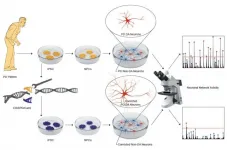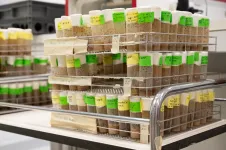Metabolic enzyme promotes neuroblastoma aggressiveness
Potential treatment may prevent cancer cells from hijacking metabolic pathways
2021-07-07
(Press-News.org) (Boston)--High-risk neuroblastoma is an aggressive childhood cancer with poor treatment outcomes. Despite intensive chemotherapy and radiotherapy, less than 50 percent of these children survive for five years. While the genetics of human neuroblastoma have been extensively studied, actionable therapeutics are limited.
Now researchers in the Feng lab at Boston University School of Medicine (BUSM), in collaboration with scientists in the Simon lab at the Perelman School of Medicine at the University of Pennsylvania (Penn), have not only discovered why this cancer is so aggressive but also reveal a promising therapeutic approach to treat these patients. These findings appear online in the journal Cancer Research, a journal of the American Association for Cancer Research.
"Our work pinpoints a targeted therapy for treating this group of at-risk patients, likely leading to improved survival," said corresponding author Hui Feng, MD, PhD, associate professor of pharmacology and medicine at BUSM.
The research, led by Nicole M. Anderson, PhD, a former postdoc in the Feng lab and a current fellow in the Simon lab, combined patient sample analysis with genetic analysis of a zebrafish model of high-risk neuroblastoma and cell culture gene inactivation studies to understand the contribution of Dihydrolipoamide S-Succinyltransferase (DLST), a metabolic enzyme, and found that it promotes metastatic spread of this type of cancer.
"We show that elevated DLST expression not only predicts poor patient outcomes, but also disease aggression in human neuroblastoma. In the zebrafish model of neuroblastoma even a modest increase in DLST protein levels can accelerate neuroblastoma onset, increase tumor burden, and promote metastasis," explains Celeste Simon, PhD, co-corresponding author and scientific director and investigator at Abramson Family Cancer Research Institute, UPenn at Penn. Conversely, they found a 50 percent reduction in DLST impairs neuroblastoma initiation and suppresses tumor aggression. DLST depletion in human neuroblastoma cells decreases cell growth and induces apoptosis (cell death).
The researchers utilized cell lines together with zebrafish and mouse neuroblastoma models to test the therapeutic efficacy of IACS-010759, a drug that is in clinical trials for treating other cancers. "Our studies revealed that human neuroblastoma cells are sensitive to IACS treatment, which slowed tumor cell growth in all models tested," said Feng.
She hopes that this study will provide IACS-010759 as a targeted therapy for children with this aggressive disease.
INFORMATION:
Funding was provided by: N.M. Anderson: Alex's Lemonade Stand Foundation, GR-000000165. J. Athoe and A. Lam: Boston University, Undergraduate Research Opportunity Award. J. Athoe and A. Kennedy: Alex's Lemonade Stand Foundation, Pediatric Oncology Student Training Award. A.T. Look: NIH, R35CA210064. M.C. Simon: NIH, P01 CA104838 and R35 CA197602. H. Feng: NIH, CA134743 and CA215059; Boston University, 1UL1TR001430 and Ralph Edwards Career Development Professorship; Leukemia Research Foundation, Young Investigator Award; the American Cancer Society, RSG-17-204-01-TBG; and St. Baldrick Foundation, Career Development Scholar Award.
ELSE PRESS RELEASES FROM THIS DATE:
2021-07-07
An international research team has found that despite being the world's leading cause of pain, disability and healthcare expenditure, the prevention and management of musculoskeletal health, including conditions such as low back pain, fractures, arthritis and osteoporosis, is globally under-prioritised and have devised an action plan to address this gap.
Project lead, Professor Andrew Briggs from Curtin University said more than 1.5 billion people lived with a musculoskeletal condition in 2019, which was 84 per cent more than in 1990, and despite many 'calls to action' and an ever-increasing ageing population, health systems continue to ...
2021-07-07
Screens may be larger on smartphones now, but nearly every other component is designed to be thinner, flatter and tinier than ever before. The engineering requires a shift from shapely, and bulky lenses to the development of miniaturized, two-dimensional metalenses. They might look better, but do they work better?
A team of Japan-based researchers says yes, thanks to a solution they published on July 7th in Applied Physics Express, a journal of the Japan Society of Applied Physics.
The researchers previously developed a low-reflection metasurface -- an ultra-thin interface that can manipulate electromagnetic ...
2021-07-07
Researchers from IDIBELL and the University of Barcelona (UB) have described that neurons derived from Parkinson's patients show impairments in their transmission before neurodegeneration.
For this study, it has been used dopaminergic neurons differentiated from patient stem cells as a model.
Parkinson's is a neurodegenerative disease characterized by the death of dopaminergic neurons. This neuronal death leads to a series of motor manifestations characteristic of the disease, such as tremors, rigidity, slowness of movement, or postural instability. In most cases, the cause of the disease is unknown, however, mutations in the LRRK2 gene are responsible for 5% of cases.
Current therapies against Parkinson's are focus on alleviating the symptoms but do not stop its progression. It ...
2021-07-07
Scientists at the University of Southampton have discovered that changes in Earth's orbit may have allowed complex life to emerge and thrive during the most hostile climate episode the planet has ever experienced.
The researchers - working with colleagues in the Chinese Academy of Sciences, Curtin University, University of Hong Kong, and the University of Tübingen - studied a succession of rocks laid down when most of Earth's surface was covered in ice during a severe glaciation, dubbed 'Snowball Earth', that lasted over 50 million years. Their findings are published in the journal Nature Communications.
"One ...
2021-07-07
By combining two distinct approaches into an integrated workflow, Singapore University of Technology and Design (SUTD) researchers have developed a novel automated process for designing and fabricating customised soft robots. Their method, published in Advanced Materials Technologies, can be applied to other kinds of soft robots--allowing their mechanical properties to be tailored in an accessible manner.
Though robots are often depicted as stiff, metallic structures, an emerging class of pliable machines known as soft robots is rapidly gaining traction. ...
2021-07-07
Despite having been formalized as a species in 1936, Wolbachia pipientis remains an elusive microbe. The reason why relates to the relationship it establishes with its hosts. Wolbachia lives inside the cells of 40% of the arthropods, in their majority insects, intertwined in a symbiosis so complex that it can no longer survive on its own. "Guessing what it takes to grow and manipulate it outside the host might not be possible", says Luís Teixeira, IGC principal investigator. And, so far, despite countless attempts, no one has succeeded in culturing this bacterium or modifying its genetic sequence.
Before joining the team led by Luís Teixeira, Elves Duarte was interested in studying the symbiosis between ...
2021-07-07
East Hanover, NJ. July 7, 2021. A team of researchers identified nine meaningful reasons that prevent people with disabilities from seeking employment. Their findings provide a much-needed understanding of this population's motives for remaining unemployed, which can inform programs and policies that promote labor force participation of people with disabilities. The article, "Understanding Persons with Disabilities' Reasons for Not Seeking Employment" (doi: 10.1177/00343552211006773) was published in Rehabilitation Counseling Bulletin on April 15, 2021.
The authors are Denise C. Fyffe, PhD, Anthony H. Lequerica, PhD, and John O'Neill, PhD, of Kessler Foundation; Courtney Ward-Sutton, PhD, and Natalie F. Williams, PhD, of Langston University; and Vidya Sundar, OT, PhD, ...
2021-07-07
Palo Alto, CA--Dehydrated plant seeds can lay dormant for long periods--over 1,000 years in some species--before the availability of water can trigger germination. This protects the embryonic plant inside from a variety of environmental stresses until conditions are favorable for growth and survival. However, the mechanism by which the baby plant senses water and reactivates cellular activity has remained a mystery until now.
New work jointly led by Carnegie's Yanniv Dorone and Sue Rhee and Stanford University's Steven Boeynaems and Aaron Gitler discovered a protein that plays a critical "go, or no-go" role in this process--halting germination if the soil's hydrological conditions are ...
2021-07-07
The principle that form follows function does not only apply to design and architecture. It also applies to biology. Every organism is a universe that lives thanks to the activities of tens of thousands of nanomachines, whose functions depend on their forms. Biologists say macromolecular complexes instead of nanomachines and structure instead of form, but the idea is the same: know the form and you will understand the function. Now, a group at the Spanish National Cancer Research Centre (CNIO) has helped determine the structure of a nanomachine essential for the functioning of another, mTOR, which plays fundamental roles in ...
2021-07-07
A team led by researchers from Queen Mary University of London has developed a new artificial intelligence (AI) tool that is able to automatically measure the amount of fat around the heart from MRI scan images.
Using the new tool, the team was able to show that a larger amount of fat around the heart is associated with significantly greater odds of diabetes, independent of a person's age, sex, and body mass index.
The research is published in the journal Frontiers in Cardiovascular Medicine and is the result of funding from the CAP-AI programme, which is led by Barts Life Sciences, a research and innovation partnership between Queen Mary University of London and Barts Health NHS Trust.
The distribution of fat in the body can influence a person's ...
LAST 30 PRESS RELEASES:
[Press-News.org] Metabolic enzyme promotes neuroblastoma aggressiveness
Potential treatment may prevent cancer cells from hijacking metabolic pathways




